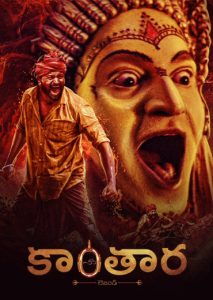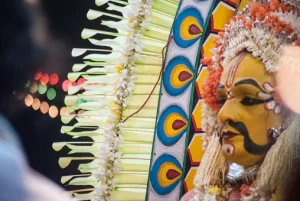25 Oct The Kantara movie controversy, IPC section 505
Kantara Movie-It’s Controversy
The topic is based on the Controversy over the practice of ‘bhoota kola’ in the Kantara Movie.
Context
- The police have booked Chetan, a Kannada actor under Section 505 (2) of IPC. Seshadripuram police have registered a case against the Kannada actor Chetan, which states that the actor is insulting and allegedly hurting the sentiments of the community.
- Bengaluru state police registered a case against Chetan under Indian Penal Code section 505 (2) (Statements creating or promoting enmity, hatred or ill-will between classes)

Pic: Kantra Movie
About Kantara Movie:
- The Kantara movie is based on a fictional story, it is inspired by the relationship between human beings and forests that takes place over two centuries.
- In 1847, a King was travelling to find peace of mind and he ended up in a forest. There he finds preternaturally found in the form of Panjuri which is a divine spirit that protects the forest and its inhabitants.
- Then the King urged the forest dwellers to let the Panjuri return with him, and in consideration of this favour, the kind will give the rights over the forest lands.
- Then the film moves to the 1990s, the forest residents come up with a new bureaucratic term forest officer who declared the forest as a ‘reserve forest’. Meanwhile, a descendant of the king has become the “landlord” of the forest dwellers now. Shetty plays the unofficial, youth leader. Shetty is also a descendant of the family that traditionally performs “Bhoot Kola ” an animist form of worshipping the traditional god, commonly practised in coastal Karnataka.
- The issue is related to the Bhoot Kola
What is bhoota Kala :
- In Tulu Bhoota means “spirit” and “Kola ” means to play.
- It is an annual ritual performance where local spirits or deities are worshipped.
- Tulu is a Dravidian language, speakers are concentrated in Dakshina Kannada and the southern part of Udupi of Karnataka in southwestern India and in the northern parts of the Kasaragod district of Kerala.
- It is primarily a spirit worship ritual practiced by Tulu-speaking people in Dakshina Kannada in Karnataka and some districts of Kerala.
- They worship the local deity, who protects their land and the practice has been continuing for the last 300 to 500 years.
- Kola is also called ‘nema’ which means ceremony, which goes on from dusk to dawn.
- The Kola is performed by trained persons, and usually, they belong to the lower castes of society
- The person who performs the kola usually wears a skirt of tender palm leaves which is easily flammable and helps them to perform acts with fire.
- The performer exhibits an aggressive outlook, dances fiercely, and performs multiple rituals.
- This performer is feared and respected by the people of the community and is believed to give answers to people’s problems on behalf of the spirit.
- The area is decorated with flowers, mainly jasmine, firecracker flower (Abbolige/ Abboli), and others.
- Drums and music give company to the dancing and pooja rituals.
- the community seeks God’s blessing, prosperity, and riddance of various problems the community is challenged with while praying together during Bhootada Kola
- Bhootada Kola is believed to have some influence from Yakshagana, which is a more popular and widely performed folk dance in the coastal regions of Karnataka.
- A few of the Bhoota Kola rituals also involve walking on a bed of hot coal.
- Popular Bootas:
- Some of the popular gods (Bhootas) worshipped as part of Bhootada Kola Panjurli, Bobbarya, Pilipoota, Kalkuda, Kalburti, Pilichamundi, KotiChennayaare.

Pic: Bhoota Kala
About the controversy
- During a press meeting, Shetty stated that the practice of Bhoota Kola is a part of Hindu culture,
- Actor-turned-activist Chetan Kumar, also Bhoota Kola was not part of Hindu tradition but of indigenous people who are Adivasis, and it had been “hijacked” by Aryans who came to India in the later years.
What is IPC?
- Mohammedan Criminal Law was changed by IPC, the former one had a very close relationship with Islam. Hence, the IPC laid the foundation of secularism.
- It was widely acknowledged as a state-of-the-art code and was, indeed, the 1st codification of criminal law in the British Empire.
- The Indian Penal Code (IPC) is the official criminal code of India.
- It is a complete code intended to cover all substantive aspects of criminal law.
- On the recommendations of the first law commission of India established in 1834, it was drafted in 1860, under the Charter Act of 1833 under the chairmanship of Macaulay.
- It came into force in British India during the early British Raj period in 1862.
- But, it did not apply naturally in the Princely states, as they had their own courts and legal systems until the 1940s.
- This code has since been amended many times and is now supplemented by other criminal provisions.
IPC section 505
- Whoever makes, publishes or circulates any statement, rumour or report
- With intent to cause, or which is likely to cause, any officer, soldier, sailor or airman in the Army, Navy or Air Force of India to mutiny or otherwise disregard or fail in his duty as such; or
- With intent to cause, or which is likely to cause, fear or alarm to the public, or to any section of the public whereby any person may be induced to commit an offence against the State or against the public tranquillity; or
- With intent to incite, or which is likely to incite, any class or community of persons to commit any offence against any other class or community, shall be punished with imprisonment which may extend to three years, or with fine, or with both.
- Statements creating or promoting enmity, hatred or ill will between classes
- Whoever makes, publishes or circulates any statement or report containing rumour or alarming news with intent to create or promote, or which is likely to create or promote, on grounds of religion, race, place of birth, residence, language, caste or community or any other ground whatsoever, feelings of enmity, hatred or ill-will between different religious, racial, language or regional groups or castes or communities, shall be punished with imprisonment which may extend to three years, or with fine, or with both.
- An offence under sub-section (2) committed in place of worship, etc- Whoever commits an offence specified in sub-section (2) in any place of worship or in any assembly engaged in the performance of religious worship or religious ceremonies, shall be punished with imprisonment which may extend to five years and shall also be liable to fine.
Daily Current Affairs for UPSC
Are you looking for the latest Current Affairs for UPSC Examination? Plutus IAS provides you with the updated and latest Daily Current Affairs for UPSC examination free of cost. The topic described above is related to Economic & Social Development. Nowadays it is very important for any UPSC aspirant to reading Daily Current Affairs for UPSC examination. So everybody should accustom to reading Daily Current Affairs for UPSC examination.
Sources



No Comments